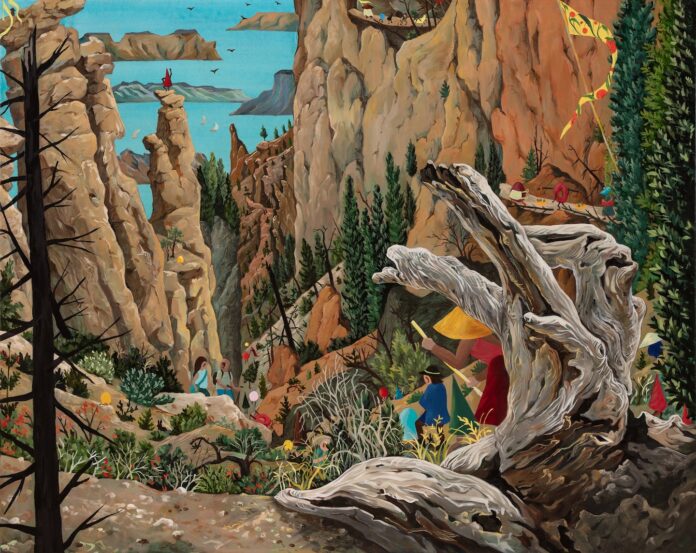Jung’s half of the show consists of 10 works on paper or canvas and eight electronic monitors that display videos that incorporate a still picture hung nearby. The various works share a similar mood but are executed in a variety of styles. Some are in color and fully realized; others are black-and-white and sketchier. A few of Jung’s videos incorporate photographic images, placing his vignettes more firmly in everyday actuality. Throughout the mutations in mode and medium, a strong sense of reality prevails.
Lim’s approach is more surrealistic, but never in an ominous way. Hikers and kayakers share the spectacular terrain with fanciful creatures derived from Bosch, but the Flemish-style apparitions appear no more menacing than the colorful blooms that dot many of the canvases. Perhaps Lim, who has spent much of her life outside her native South Korea, has found foreign climes to be more picturesque than unsettling.
The contrast between Jung’s and Lim’s work may be a matter of individual sensibility, or of generational outlook. (Lim was born 23 years after Jung.) What they share is an ability to fuse objective reality with subjective outlook. The places Jung and Lim depict may look slightly or even entirely familiar, yet they belong to the artists alone.
Lim Hyunjeong and Jung Seok Hee: Landscape of the Mind Through Sept. 8 at the Korean Cultural Center, 2370 Massachusetts Ave. NW. washingtondc.korean-culture.org/en. 202-939-5688.
Hugging a long, curving wall in the National Academy of Sciences’s second-floor gallery, the video installation “Blue Dreams” is as immersive and expansive as an ocean view. Yet the imagery that flits across the seven contiguous screens depicts the seas’ microbial networks, which a gallery note calls “our planet’s smallest yet most vital living systems.” Devised by Rebecca Rutstein and the Ocean Memory Project, the video uses photographic, abstract and computer-generated material to render visible the infinitesimal.
Rutstein is a Philadelphia multidisciplinary artist who worked on “Blue Dreams” principally with four scientists: environmental microbiologist Rika Anderson, marine biogeochemist Samantha (Mandy) Joye, biomedical engineering professor Shayn Peirce-Cottler and bioengineer Tom Skalak. Their collaboration led from science to art, but sometimes went the opposite direction. Peirce-Cottler, for example, generated models of deep-sea microbial growth patterns based on Rutstein paintings.
Earthly life began in the ocean, a development evoked by the video’s suggestions of underwater volcanoes and heat vents, and its burbling soundtrack. Shimmering green waves resemble the northern and southern lights, while superimposed pixel patterns suggest everything from microorganisms to continental land masses. The video is short but presented in a loop that is suitably endless. Should the processes represented in “Blue Dreams” end, so would our existence.
Rebecca Rutstein and the Ocean Memory Project: Blue Dreams Through Sept. 15 at the National Academy of Sciences, 2101 Constitution Ave. NW. cpnas.org/exhibitions. 202-334-2415.
Even if it weren’t the most graceful crossing between D.C. and Arlington, Va., the Francis Scott Key Bridge would be impressive simply because of its location. Stretching between two towering bluffs, the bridge crosses the Potomac near where the river transitions from wide and easygoing to rocky and wild. This dramatic siting surely is one reason Eric Johnson began photographing Key Bridge about seven years ago, perhaps looking forward to its 2023 centennial.
The black-and-white photos in Johnson’s “Key Bridge,” at Multiple Exposures Gallery, gaze at and from the bridge. They include close-ups and panoramas; pictures made with long exposures or narrow depth of field; and views that emphasize the transcendently natural or the dispiritingly man-made. The photographer is alert to visual and thematic contrasts: A jetliner soars above a bridge-crossing bicyclist, and arrows painted officially on the bridge’s pavement vs. graffiti added illicitly to its supports.
The river flows through many of the images, but Johnson also depicts water in the air. In these shots, the bridge is often bathed in mist or rain, yielding droplets that bead softly on hard surfaces. Key Bridge is solid 100 years on, but Johnson finds moments in which it almost disappears.
Eric Johnson: Key Bridge Through Sept. 10 at Multiple Exposures Gallery, Torpedo Factory, 105 N. Union St., Alexandria. multipleexposuresgallery.com. 703-683-2205.
For visual artists to be motivated by music is not unusual. But something a little different is happening when Stephen Bates cites composer Richard Strauss as an inspiration for “Abstraction as Narrative,” his Watergate Gallery show. Before turning to sculptural collage-paintings, Bates played clarinet in the Kennedy Center Opera House Orchestra for 36 years. The artist, who now lives in Massachusetts, has a sense of rhythm that truly was developed by music.
Usually wall-mounted but sometimes free-standing, Bates’s vivid creations are made mostly of paper, cloth, plaster and paint. The pieces often feature crescents or lattices and sometimes both. Their titles refer to motion — often dancing — chronology or geographical places. “Night Time in the City” arrays a rainbow of colors across a relief grid whose regularity implies the repeated geometric elements of urban architecture, while the exuberantly 3D “Tanada” (named for a terraced Japanese rice field) juxtaposes eccentric organic forms.
Sans title, that rice field could be read, perhaps, as an abstracted tropical bird. Such a creature would be at home in the junglelike vines and spirals of another collage, tellingly called “First Jazz Improvisation.” Sometimes Bates gets looser than his orchestral background might suggest.
Stephen Bates: Abstraction as Narrative Through Sept. 30 at Watergate Gallery, 2552 Virginia Ave. NW. watergategalleryframedesign.com. 202-338-4488.



